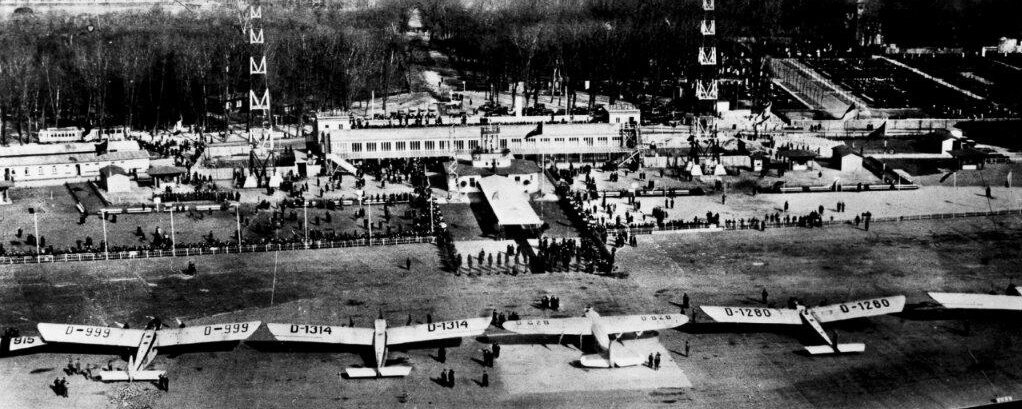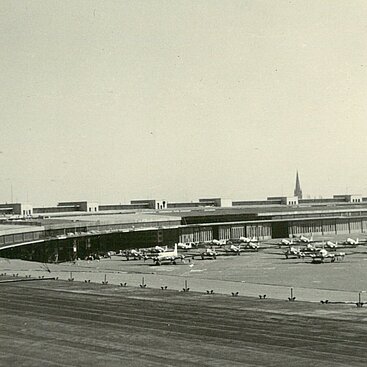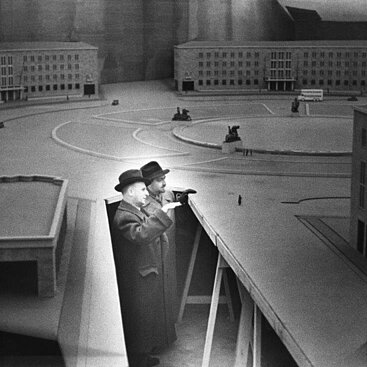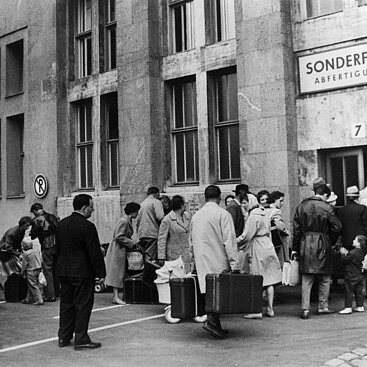Tempelhof airport
Petrol engines and propellers remained the only feasible propulsion methods of aircrafts until the discovery of jet propulsion. In the 1920s and 1930s, civil aviation was engaged the development of larger and faster aircrafts with more space and comfort for passengers as well as expansion of route network in all the regions of the world.
The Treaty of Versailles
The disarmament regulations of the treaty of peace, which the German Reich signed on 28 June 1919 in Versailles, also concerns military aviation. As the initiator and loser of the First World War, Germany had to dissolve its air force, destroy its plants and aircrafts or hand them over to the victorious powers. Initially, the agreement did not apply to civil aviation. The limitations became applicable even here in May 1921 within the framework of the London Ultimatum. Because it concerned aircraft production among other things, the industry responded with relocations: Dornier now manufactured in Italy, Junkers in Russia and Sweden.
The restrictions ended with the Paris Convention of May 1926. Only the construction of armoured and armed machines continued to be prohibited. At the same time, Germany and France concluded an Aviation Convention: From June onwards, the adversaries of World War I operated an airline together between Berlin and Paris with a stop in Essen and Cologne.
Construction of the Tempelhof central airport
Owing to the requirements of the Treaty of Versailles, even the Tempelhof field, which belonged to Great Berlin since the municipal reform of 1920, could no longer be used as a parade ground. The head of the municipal planning and building control office of Berlin, Leonhard Adler, opposed the plan to develop an exhibition ground here and got involved in the construction of the airfield. Berlin should have a well-connected airport close to the city that is an alternative for the remote airports in Johannisthal and Staaken. Deutsche Aero Lloyd AG as well as Junkers Luftverkehrs AG supported the intention through preliminary financing of the first provisional buildings. They constructed a check-in and administrative building and two hangars.
On 8 October 1923, the airline Berlin-Königsberg began the first operation in Tempelhof. On the same day, the decision of the magistrate was taken to construct the Tempelhof field for Berlin central airport. A signal of the Supreme Army Command was mainly decisive in addition to the negotiating tactics sent by Adler to lower the price of the premises.
The construction of the airport could now begin speedily. At the imaginary intersection of the extended Lilienthalstraße and Paradestraße, halls were constructed in 1924/25 in the New Objectivity architectural style in the middle of what would later become the airfield. In the first phase of construction, the so-called Radio House was also built, which accommodated the air surveillance police among others. As the former predecessor of air-traffic control, it decided take-offs and landings on the basis of weather monitoring and wind direction. Maps and compass were the only aids on board.
The Berliner Flughafengesellschaft (BFG) founded in 1924 operated the airport; Leonhard Adler, who was forced into exile in 1936 by the Nazis because of his Jewish origin, was the Chairman of the Supervisory Board. Although Berlin, Prussia and even the imperial government supported the BFG, its financial position was strained; air shows are said to have catered for additional income.
The construction of the airport was completed five years later with the inauguration of the main building and was again too small. In 1930, Tempelhof was the largest airport in Europe in terms of passenger volume. Even the number of flight routes increased; 71 cities of which 25 outside are Germany are headed for Tempelhof. Further construction of the airport was not considered because of financial crisis.
Junkers Luftverkehrs AG and mainly Deutsche Aero Lloyd operated the increasingly dense transport network. In the summer of 1924, Junkers AG attempted night flight with mail transport. The first passenger flight at night flew to Königsberg in May 1926. The entire distance was marked with lamps and headlights; revolving spotlights were installed every 25 to 30 km; even in the night, pilots flew by VFR. Professionalisation brought about instrument flying, which was possible in Tempelhof as of 1930 and was part of the compulsory training for Luft Hansa pilots. With transoceanic flights, the transatlantic transport was ready for aircrafts, which were superior to ships and airships all along because of their speed.
Pioneers of transatlantic flights
On 20th and 21st of May 1927, Charles Lindbergh succeeded in his first “solo crossing” of the Atlantic in his single-engine “Spirit of Saint Louis”. He flew from New York to Paris with no intermediate stops in 33.5 hours. After the first non-stop Atlantic flight of the British aviators John Alcock and Arthur Whitten Brown in a refurbished Long Range Bomber of the First World War on 14 and 15 June 1919, the American pilot Lindbergh, because of his solo performance, became one of the most prominent protagonists in the history of aviation.
Even the Airport Tempelhof and Berlin public took part in this spectacular development. On 7 June 1927, Clarence D. Chamberlin with passenger (and navigator) Charles Levine in “Columbia” landed on the Berlin airfield. They flew from New York to Berlin with a distance of almost 6300 kilometres in 43 hours. In remembrance of this track record, the Prinz-August-von-Württemberg-Straße was renamed to Columbiastraße.
In the following year, Ehrenfried Freiherr von Hünefeld, Hauptmann Hermann Köhl and Major James A. Fitzmaurice were successful in their transatlantic return visit. The Irishman and both the Germans flew in Junkers W 33 “Bremen” against the main wind direction from east to west across the ocean for the first time. After the successful start in Ireland, they reached USA in 36.5 hours and were personally honoured there by President Hoover. The Berliners greeted the trio enthusiastically during their visit to Tempelhof in June 1928.
Comfort for passengers
Since the beginning of 1920s, continental commercial aviation was becoming more and more attractive to the passengers. The airlines now offered aircrafts with closed cabins - gone was the era of flying gear, crash helmets and safety goggles, which the passengers received on loan from the airline. There now were picnic baskets on board small single-engine aircrafts; complete meals were offered on German Sunday connecting flights as on 1928. With the introduction of four-engine Ju 90 and Focke-Wulf Fw 200 “Condor” began the era of flight attendants – a service for which trained nurses were initially engaged by Boeing Air Transport in 1930. Armchairs, smoker's lounges and sleeping cabins offered on board all imaginable convenience.
Larger and faster aircrafts like Junkers Ju 52, Tante Ju, Ju 160 or Focke Wulf Fw 200 “Condor” brought more and more people to their destination in lesser and lesser time in 1930s. With the single-engine Heinkel He 70, the fastest commercial aircraft of its time, Lufthansa, renamed since a year, launched its “lightning distance” from Berlin to Frankfurt am Main in 1934. If flying was thus far hardly faster than a train journey not least because of the location of the airports, flights now really saved time. Aircrafts occupied top position under means of transport.
Development of Lufthansa
Allgemeine Elektricitäts-Gesellschaft (AEG), Deutsche Bank, Hapag and Luftschiffbau Zeppelin supported the “Deutschen Luft-Reederei GmbH” (DLR) founded in 1917, the first company to provide passenger transportation via aircrafts throughout the world. After establishing the first commercial scheduled air service from Berlin to Weimar in the year 1919, Hamburg, Gelsenkirchen and Swinemünde became the destinations soon after for mail and passenger service. The aircrafts of DLR already bore a crane on the empennage designed by Otto Firle.
The founding boom in the young business branch “commercial aviation” quickly led to mergers given the economic pressures. Against the competition of Junkers Flugzeugwerke in Dessau, DLR and Lloyd Luftdienst GmbH in Berlin merged to form Deutschen Aero Lloyd AG in February 1923. Reich Ministry of Transport intervened at the peak of competition in 1925. It wanted to separate industrial and transportation interests and offer financial recovery to Junkers factories, which were in acute financial crisis, when Junkers ceded its transportation sector to the Ministry and at the same time pressed for another “market shake-out”. On 6 January 1926, Deutsche Luft Hansa AG emerged from the merger of Aero Lloyd and Junkers. The colours of Junkers Luftverkehrs AG combined with the crane of DLR resulted in the well-known blue-yellow logo of Lufthansa. Tempelhof was its base airport until 1945.
In the summer of 1926, Luft Hansa already operated 64 airlines. In order to prepare for long routes, it undertook expedition flights, for example, to East Asia or Brazil. In 1926, two Junkers G 24 flew to Peking and a flying boat Dornier Wal to South America in ten stages. At the same time, a network was established for freight and postal routes and experiences of long-distance flights collected. In 1932, Luft Hansa was at the forefront among airlines. Its fleet comprised 155 aircrafts, route network of more than 27500 kilometres. Tempelhof was its centre.
After the hand-over of power to the Nazis, the Ministry of Transport forfeited its responsibility related to the issues of aviation. From May 1933, the Reich Air Minister, Hermann Göring, was competent for consulting the entire aviation industry for the build-up of the Air Force, which was initially confidential. The Lufthansa aircrafts bore the swastika on the empennage until 1945.
St. Endlich, M. Geyler-von Bernus, B. Rossé
Literature
Deutsche Lufthansa (editor), origin and destination: Berlin, no place of publication, 1985
Museum for transport and technology (editor), Hundred years of German aviation. Lilienthal and his heirs, Gütersloh/Munich 1991
Hans Werner Neulen, Deutsche Lufthansa. The crane in turbulence 1939-1945, Lemwerder 2003
Frank Schmitz, Airport Tempelhof. Berlin’s Gateway to the World, Berlin 1997
Michael Thiele, around the world from Berlin, in: District Office of Tempelhof, Berlin (editor), Landing on Tempelhof. 75 years of central airport – 50 years of airlift, exhibition catalogue, Berlin without date specification (1998)





